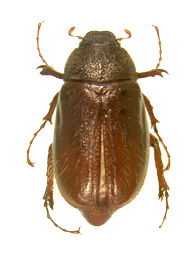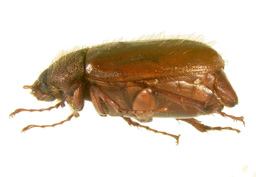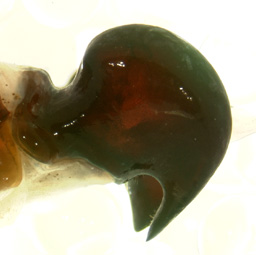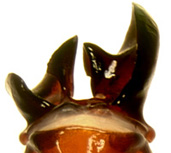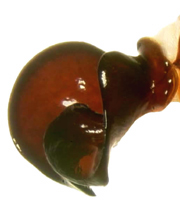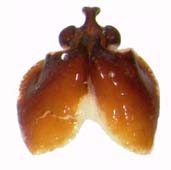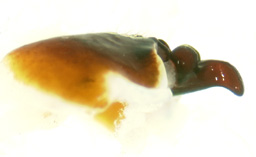 |
|||||||
|
|||||||
Phyllophaga comosa Davis 1920
|
||
| Melolonthinae Tribes | ||
|
||
|
||
| Melolonthinae Taxa Map | ||
| Phyllophaga catalog | ||
| Phyllophaga gallery | ||
| Phyllophaga genitalia gallery |
Phyllophaga hirticula
Photos by: Maxi Polihronakis
Left Lateral View
Dorsal View
Phyllophaga hirticula Male Genitalia
Photos by: Maxi Polihroankis
Phyllophaga hirticula Female Genitalia
Photos by: Maxi Polihronakis
Phyllophaga hirticula distribution
.
Distribution: Eastern United States: Alabama, Arkansas, Connecticut, Deleware, Florida, Georgia, Iowa, Illinois, Indiana, Kansas, Kentucky, Louisiana, Massachusetts, Maryland, Michigan, Missouri, Mississippi, North Carlina, Nebraska, New York, Ohio, Pennsylvania, Rhode Island, South Carolina, South Dakota, Tennessee, Virginia, Wisconsin, West Virginia.
Remarks: Unlike most Phyllophaga species, P. hirticula is easily identified by the evenly spaced rows of elytral setae. However, there is a variety of P. hirticula, P.hirticula var. comosa, found in Kansas and Nebraska with no elytral setae.
Biological data: P. hirticula has a three-year life cycle in northern states, and a potentially truncated two-year life cycle in southern states. Brood emergence can be periodic with inconsistent numbers from year to year. Pest status of P. hirticula is primarily concentrated to the bluegrass region of Kentucky.
Temporal distribution: Adult emergence begins as early as March and April in southern states. In northern states, adult emergence typically takes place in May.
Original Description:
Knoch, A. W. 1801. Neue Beyträge zur Insectenkunde. Theil 1. Schwickertschen Verlage, Leipzig. 208 pp.
Glasgow (1916) designated P.hirticula as the type species of Phyllophaga by subsequent designation.
References:
Böving, A. G. 1942. A classification of larvae and adults of the genus Phyllophaga (Coleoptera: Scarabaeidae). Memoirs of the Entomological Society of Washington 2:1-95.
Glasgow, R. D. 1916. Phyllophaga Harris (Lachnosterna Hope): A revision of synonymy, and one new name. Bulletin of the Illinois State Laboratory of Natural History 11:365-379.
Horn, G. H. 1887. Revision of the species of Lachnosterna of America North of Mexico. Transactions of the American Entomological Society 19:209-297.
Luginbill, P., and H. R. Painter. 1953. May beetles of the United States and Canada. United States Department of Agriculture Technical Bulletin 1060:1-102.
Smith, J. B. 1888. Notes on the species of Lachnosterna of temperate North America, with descriptions of new species. Proceedings of the United States National Museum 11:481-525.
Woodruff, R. E., and B. M. Beck. 1989. The scarab beetles of Florida Part II. Florida Department of Agriculture and Consumer Services, Gainesville, Florida.
| .... Entomology Home | Research | UNSM Entomology Database | Scarab Workers |
Generated on: 22 Feb 2007
University of Nebraska-Lincoln State Museum - Division of Entomology
